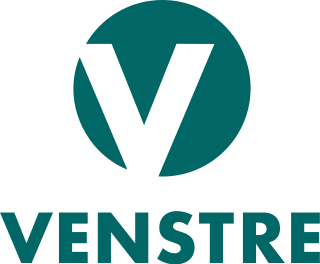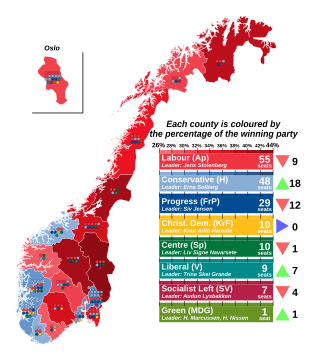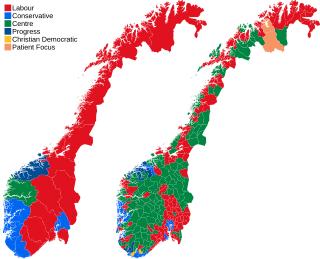The politics of Norway take place in the framework of a parliamentary, representative democratic constitutional monarchy. Executive power is exercised by the Council of State, the cabinet, led by the prime minister of Norway. Legislative power is vested in both the government and the legislature, the Storting, elected within a multi-party system. The judiciary is independent of the executive branch and the legislature.

The Storting is the supreme legislature of Norway, established in 1814 by the Constitution of Norway. It is located in Oslo. The unicameral parliament has 169 members and is elected every four years based on party-list proportional representation in nineteen multi-seat constituencies. A member of the Storting is known in Norwegian as a stortingsrepresentant, literally "Storting representative".

The Labour Party, formerly The Norwegian Labour Party, is a social-democratic political party in Norway. It is positioned on the centre-left of the political spectrum, and is led by Jonas Gahr Støre. It is the senior party in a minority governing coalition with the Centre Party since 2021, with Støre serving as the current Prime Minister of Norway.

The Christian Democratic Party is a Christian-democratic political party in Norway founded in 1933. The party is an observer member of the European People's Party (EPP). It currently holds three seats in the Parliament, having won 3.8% of the vote in the 2021 parliamentary election. The current leader of the party is Olaug Bollestad.

The Socialist Left Party is a democratic socialist political party in Norway. Positioned on the left-wing of the political spectrum, it is opposed to European Union and the European Economic Area membership. SV supports a strong public sector, stronger social welfare programs, environmentalism, and republicanism. As of 2018, the party had 11,385 members; the number has steadily increased since a low point in 2015. The party leader is Kirsti Bergstø, who was elected on 18 March 2023
Norway elects its legislature on a national level. The parliament, the Storting, has 169 members elected for a four-year term by a form of proportional representation in multi-seat constituencies.

The Liberal Party is a centrist political party in Norway. It was founded in 1884 and it is the oldest political party in Norway. It is positioned in the centre on the political spectrum, and it is a liberal party which has over the time enacted reforms such as parliamentarism, freedom of religion, universal suffrage, and state schooling.

Parliamentary elections were held in Norway on 11 and 12 September 2005. The result was a victory for the opposition centre-left Red-Green Coalition, which received 48.0% of the votes and won 87 out of 169 seats, dominated by the Labour Party's 61 seats. The three-party centre-right government coalition won 44 seats and the right wing Progress Party won 38, becoming the largest opposition party. Voter turnout was 77.1%, an increase of 2 percentage points compared to the 2001 elections.
Leveling seats, commonly known also as adjustment seats, are an election mechanism employed for many years by all Nordic countries in elections for their national legislatures. In 2013, Germany also introduced national leveling seats for their national parliament, the Bundestag. The electoral reform in Germany in 2023 removed the leveling seats, and replaced them with Zweitstimmendeckung. Leveling seats are seats of additional members elected to supplement the members directly elected by each constituency. The purpose of these additional seats is to ensure that each party's share of the total seats is roughly proportional to the party's overall shares of votes at the national level.
The Red Party is a communist political party in Norway. It was founded in March 2007 by a merger of the Red Electoral Alliance and the Workers' Communist Party. A Marxist party, it has been described as left-wing and far-left on the political spectrum. In its political programme, the Red Party sets the creation of a classless society to be its ultimate goal, which the party says is "what Karl Marx called communism". The party's other goals are replacing capitalism with socialism, an expansive public sector and nationalisation of large enterprises. It has a revolutionary socialist ideology, which aims towards new legislatures taking power on behalf of the workers, though the party does not support violent armed revolution as espoused by its predecessors in the 1970s and 1980s. It strongly opposes Norway becoming a member of the European Union.

Parliamentary elections were held in Norway on 13 and 14 September 2009. Elections in Norway are held on a Monday in September, usually the second or third Monday, as determined by the king. Early voting was possible between 10 August and 11 September 2009, while some municipalities also held open voting on 13 September. Voters elected 169 members for the Storting, each for a four-year term. Voter turn-out in the 2009 general elections was 76.4%.

Bente Thorsen is a Norwegian politician representing the Progress Party. She has been a member of the Storting since following the 2009 parliamentary election as Rogaland's 12th representative. She was a deputy representative between 2005 and 2009.

Parliamentary elections were held in Norway on 8 and 9 September 2013 to elect all 169 members of the unicameral Storting. The centre-right coalition obtained 96 seats, while the incumbent red–green coalition government obtained 72 seats and the Green Party obtained one. The Labour Party won the largest share (30.8%) of the votes cast, with the Conservatives coming second (26.8%), after increasing its share by 9.6 percentage points.

Parliamentary elections were held in Norway on 11 September 2017 to elect all 169 members of the unicameral Norwegian Parliament, the Storting. The non-socialist parties retained a reduced majority of 88 seats, allowing Prime Minister Erna Solberg's Conservative-Progress coalition to remain in government. The Liberal Party joined the coalition in January 2018 but it remained a minority cabinet until the Christian Democratic Party joined the coalition in 2019. The three largest centre-left parties won 79 seats. The Green Party retained its single seat, while the Red Party won its first ever seat.

Parliamentary elections were held in Norway on 13 September 2021. All 169 seats in the Norwegian legislature, the Storting, were up for election.
The 2013 Norwegian Sámi parliamentary election was held on 9 September 2013, simultaneously with the 2013 Norwegian parliamentary election. All 39 seats in the Norwegian Sámi parliament, the Sámediggi, were up for election.
















